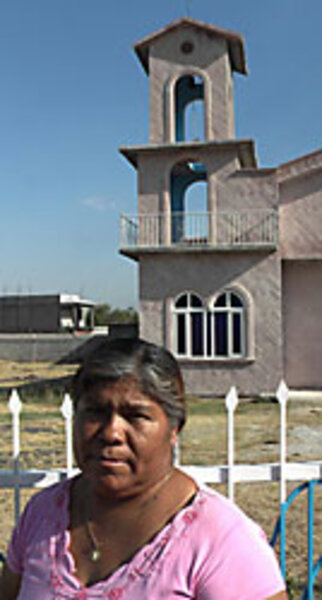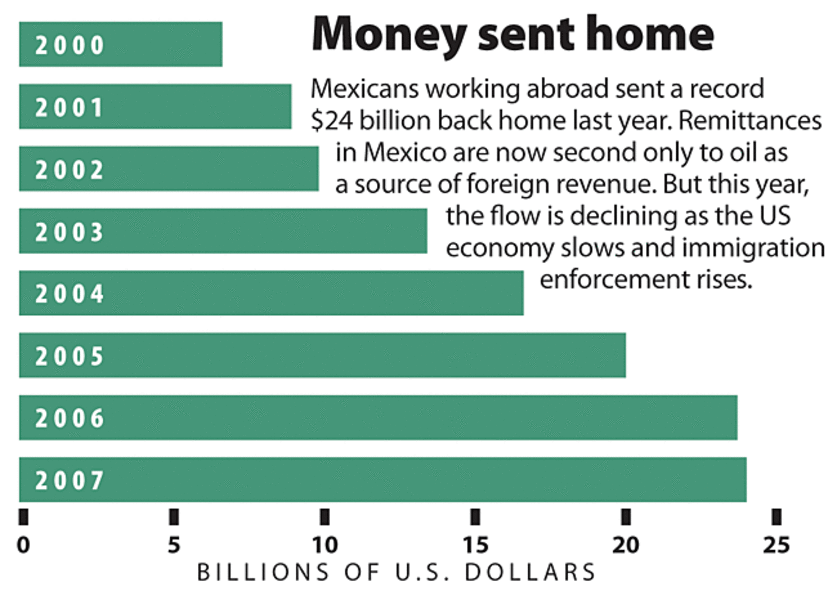Mexicans in the U.S. sending fewer dollars home
Loading...
| Emiliano Zapata, Mexico
When the finishing touches were put on this coral-pink Roman Catholic church last year, residents beamed. Our Lady of Guadalupe was the first church built here – and it was only made possible by the toil of sons, husbands, and brothers in the US.
But today, many suspect this will be the last new edifice of any kind in some time. The flow of cash sent from the US, which over the years has helped pave the main road, build a basketball court, and construct or renovate almost every home in this 500-person village in Michoacán, has suddenly become a trickle.
Since 2000, remittances nationally have quadrupled, hitting a record $24 billion last year. Money from Mexicans abroad is now second only to oil as a source of foreign revenue. But the tide is turning – and is felt most acutely in rural Mexico. Remittances dropped 2.37 percent in the first four months of this year, compared with the same period in 2007, according to Mexico's central bank.
Analysts blame a downturn in the US economy, especially in the construction industry, which employs more than 20 percent of Mexican migrants, and the tightening of US immigration rules – including jail time in border states and greater state and local enforcement.
Mexico isn't alone in the revenue loss.
Only half of Latin American immigrants in the US, two-thirds of whom are Mexican, are sending home money on a regular basis, compared with 73 percent two years ago, according to a survey this year by the Inter-American Development Bank.
Here in the village of Emiliano Zapata, Cristina Calderon Luis, whose husband went to Illinois three years ago, right after they married, says she's no longer able to purchase the sand, cement, and bricks she'd been stockpiling so they could build their own home one day. For the past several months, her husband has been out of a job. "He doesn't have anything to send," she says.
"About 2 million fewer Mexican adults are receiving remittances. That will obviously have a substantial impact on the lives of those households," says Donald Terry, general manager of the Multilateral Investment Fund at the Inter-American Development Bank. "There is a great deal of uncertainty, a great deal of fear for the future. When you are uncertain of where you are going to be, your inclination is to put some money aside."
Many countries in Latin America, with strengthening domestic markets and a more diversified global economy, are better prepared to handle the consequences of a US downturn today than they were in 2001, says Alfredo Coutino, a senior economist for Latin America at Moody's Economy.com. Mexico's economy is more vulnerable than others because of its close trading relationship with the US, but it is still expected to weather a US slowdown, he says, with gross domestic product growth (3.3 percent in 2007) forecast to drop only slightly for this year.
But Mexico has increasingly grown dependent on remittances, and the loss is already being widely felt, particularly in the agricultural heartland from where so many migrants hail.
Of all the states in Mexico, it is Michoacán that receives the most money from the US each year, according to Mexico's central bank. Entire towns have left in search of jobs in the US construction, agricultural, and service industries. And it is here that the decline in remittances has been most dramatic – starting even before the national decline, says Heliodoro Gil Corona, an economist at Michoacán's School of Economists. He says remittances have fallen by 8 percent statewide since 2005, representing more than $330 million lost to households across the state.
In Emiliano Zapata, a village that sits on a hill miles from the main highway, Juana Ayala Pastor is feeling the loss. Her son, who works on farms in Oregon, now sends money only sporadically to their 11-member household. "His money was our only source of hope," she says. The $500 received religiously each month is now an occasional $200. He could not find a job for six months.
In the Inter-American Development Bank survey, 81 percent of Latin American immigrants said they were having a harder time finding well-paying jobs compared with a year ago.
Ms. Ayala Pastor's immediate solution has been to stop buying cooking gas; she cooks entirely over an open fire now. Other families here are also feeling the pinch. Some parents weren't able to put money into the children's school fund collected at the beginning of each year for books and uniforms. But the biggest concern here is putting food on the table.
Juana's sister, Socorro, another lifelong resident, says that because the town is so small, when they are short on cash they can buy food from the local stores on credit. But they are also taking their own measures.
A group of women here is working with a local non-profit called the Women's Team for Solidarity Action to grow organic corn, beans, pumpkin, and garbanzos in parcels they own, and cilantro, scallions, and chilies on their front patios. "It's to save a little money," Socorro says.
"We worry most about them getting enough to eat, and with [Mexican] agriculture shifting to a focus on making money instead of feeding people, we are trying to convince them to go back to their traditional practices of being self-sustaining," says Ana Luisa Barajas, the general coordinator for the women's group, known by its Spanish initials, EMAS.
The women have also started a communal savings account shared by some 30 families. Every eight days they contribute at least 2 pesos (about 18 cents), or as much as $20, to use in case of an emergency. [Editor's Note: The original version miscalculated the conversion rate of pesos to dollars.]
Towns must resort to such measures, says Mr. Gil Corona, in the absence of state or federal measures to address the dependence on money sent from abroad. He says that during the decade that remittances grew, the country did not use the money for development. A federal infrastructure-building program (with state and local participation) that matches remittances in a 3-to-1 ratio – this program was used to construct the church and pave the road in Emiliano Zapata – only works when remittances are plentiful, he says. He and other analysts argue that rather than spending on infrastructure, the government should have been providing matching funds for programs that create long-term employment.
Mexico acutely felt the last US recession in 2001, but remittances did not drop as quickly as they are now. That is why Mr. Terry says the role of tougher US enforcement, such as workplace raids and prosecutions for first-time crossers along the border, and a general rise in anti-immigration sentiment, may be a factor. In the Inter-American Development Bank study, 68 percent of respondents considered discrimination against immigrants a major problem. That's a sharp jump from 37 percent in 2001.
There are other reasons remittances fall, including family disintegration and, in some cases, family resettlement. Based on what she's seeing in Michoacán, Ms. Barajas says that the decline in remittances can both spur immigration and curb it.
She says that it is a catalyst for women and entire families to migrate to the US. Yet it is also drawing some men back home, as they prefer the lower-paid but steadier jobs in nearby processing plants. In the medium and long-term, however, immigration to the US, which depends so heavily on migrant labor and where Mexican households can earn 10 times the average monthly salary at home of $160, will continue, says Terry. "That's the demographic reality." [Editor's note: The original version failed to state the salary's time frame.]
But immigrants are also cognizant of economic trends and the strength of the euro versus the dollar. That means more Latin American immigrants are heading to Europe for work. For the first time this year, some Andean countries are getting more remittance money coming from Spain than from the US.
• Tomorrow: Is stiffer US-Mexico border enforcement reducing immigration?







